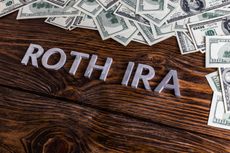Are You on Track to Retire?
How to tell if you’ve saved enough to retire when you want, and what to do if you haven’t.


Many people get serious about calculating whether they are on target to retire when they hit their fifties. That’s often when reality starts to sink in and retirement no longer seems like just a vague goal. Figuring out whether you’ll have enough assets and income to cover a retirement that can easily stretch to 30 years can be daunting, but there’s no lack of advice out there. For a quick-and-dirty way to see if you’re on track, you could check one of the multitude of savings benchmarks financial firms offer. Or you could use one of the many online retirement calculators provided by Fidelity Investments, T. Rowe Price, Vanguard and others. (Kiplinger also offers a calculator at kiplinger.com/links/retirementcalculator.)
A better way
For a more accurate estimate, you’ll have to crunch your own numbers. A few things to keep in mind: When you estimate yearly expenses in retirement, remember that you’ll no longer be contributing to retirement savings, you’ll likely pay less in taxes, and if you plan to pay off your mortgage, those payments will disappear. (You may want to boost your budget for travel and hobbies.) Don’t forget that your costs will go up with inflation (figure 3% a year).
The next step is to add up your annual sources of guaranteed income, such as Social Security and possibly a pension. To find your estimated Social Security benefits, open a “my Social Security” account online. Finally, subtract your income from expenses. What’s left is how much money you will need to draw down from your savings to maintain your lifestyle.

Sign up for Kiplinger’s Free E-Newsletters
Profit and prosper with the best of expert advice on investing, taxes, retirement, personal finance and more - straight to your e-mail.
Profit and prosper with the best of expert advice - straight to your e-mail.
You need to make sure you won’t deplete your savings too fast. One widely used guideline is to take an initial withdrawal of 4% of your nest egg and increase the dollar amount of your withdrawals each year by the annual inflation rate. Based on historical investment returns, this rule of thumb holds that there is a high probability that your nest egg will last for at least 30 years, assuming 50% or 60% of your portfolio is invested in stocks and the rest in bonds. (For more strategies, see 12 Strategies to Generate Income in Retirement.)
You may need more or less savings depending on how long you live. That’s impossible to predict, but you can get an idea at Livingto100.com, which estimates life expectancy based on your answers to questions about your health, lifestyle and family history.
If you don’t already work with a financial planner, now is a good time to find one. An adviser can address your specific situation and help you create a plan to reach your goal. (For help finding an adviser, see How to Find the Right Financial Adviser for You and Your Money.)
That’s what Steve and Mary Ingram did. Steve, 55, and Mary, 53, had been saving the maximum allowed in their IRAs and 401(k)s for years, getting the full employer match. The Albuquerque couple also boosted their contributions when they turned 50 to take advantage of the extra catch-up limits. “That’s retirement 101,” says Mary. “It’s incredible how much that builds.”
The Ingrams have been working for more than 12 years with financial adviser Donna Skeels Cygan, who is now helping them take their planning to the next level by tweaking their accounts so they’ll have tax-diversified income streams in retirement. Cygan also runs their retirement numbers under a variety of scenarios—say, in case they need long-term care—to make sure they’re truly on track.
How to stay on track
Retirement challenges for today’s younger baby boomers, now in their mid fifties, are greater than those of the oldest boomers, now entering their seventies. Younger boomers are less likely to have traditional pensions, they’ve paid more for their children’s college education, and they’ve benefited less from home appreciation, says Mary Beth Franklin, a certified financial planner and contributing editor at InvestmentNews (and a former senior editor of Kiplinger's Personal Finance). “For some people, their savings are not going to be enough,” she says. “They have to look at their alternatives.”
Your journey to retirement could also be knocked off course by a divorce, job loss or other unexpected event. Whether or not a catastrophic expense undermines your plans, these methods will help you get to your goal.
Save more
In 2018, you can contribute $18,500 on a pretax basis to a 401(k), plus another $6,000 if you’re 50 or older. As long as you turn 50 anytime this year, you can start making those catch-up contributions now.
This money will be taxed when you withdraw it in retirement. Because of this, a tax-deferred account may be depleted 25% to 35% faster in retirement than a taxable account, says Jennifer Davis, a CFP in Rockville, Md. She suggests also stashing money in a Roth IRA, which offers tax-free withdrawals in retirement, or in an after-tax investment account. This will give you flexibility to draw from different accounts to minimize taxes later.
The Ingrams are doing this. Mary splits her 401(k) contributions between a Roth and a pretax account. Steve’s employer doesn’t offer a Roth 401(k), and the couple’s joint income is too high to qualify for a Roth IRA. But he makes “backdoor” Roth contributions by contributing the full $6,500 to a traditional IRA each year and then immediately converting it to a Roth. The Ingrams are also investing $1,000 twice a month in a taxable brokerage account, on which they’ll pay lower, capital gains tax rates when they realize long-term gains.
Trim expenses
To free up more money for savings, you may have to reduce expenses—by, say, eating out less, cutting the cable cord or replacing cars less often. The budget you created to estimate expenses after retirement can also help you identify ways to trim right now. If you need to make bigger cuts, consider downsizing—perhaps to a condo closer to where you work.
After their financial planner told Denise and Mike Sikora to save more, they sold the house in New Jersey that they had lived in for 30 years and downsized to a nearby co-op, investing their home-sale profits and slashing their notoriously high New Jersey property taxes. A year later, they sold the co-op and bought a house in an even less-expensive area—a retirement community in central Florida.
Mike, 63, retired from his job as an accountant before moving to Florida. But Denise, 60, was able to continue her work as a self-employed medical claims specialist—although she has cut back her hours. The move to Florida saved them a lot of money, and not just because houses cost less than in the Northeast. Florida has no state income tax, so it doesn’t claim part of their retirement income and Social Security benefits. The Sikoras’ property taxes are now about $1,200 a year, or one-fifth what the couple paid on their New Jersey house. (See the State-by-State Guide to Taxes on Retirees.)
The Sikoras also look for other ways to cut costs. “We started keeping track of our expenses and writing down every penny we were spending,” says Denise. “It was a real eye-opener.”
Work longer
Staying on the job an extra couple of years can make a huge difference in your retirement savings because you can continue to make contributions to your retirement funds and hold off tapping them. You’ll also delay taking Social Security, thereby earning a bigger benefit. And you’ll have fewer years of retirement to fund.
Even a part-time job paying, say, $10,000 a year can be a big help. It might not sound like much, but to generate an extra $10,000 a year from your portfolio using the 4% withdrawal rule, you would need another $250,000 in savings, says Bill Hart, a CFP in Jacksonville, Fla. “Unless he already has a fabulous job, there is no way that someone is going to save himself $250,000 in the last five years of working,” he says.

Even if your retirement plans are humming along, unexpected events can force you to change gears. Barbara Reist Dillon, 58, and her husband, Jesse, 56, reassessed their plans after Jesse’s employer offered him a buyout. The Lancaster, Pa., couple visited financial planner Rick Rodgers to see if their retirement would stay on track without Jesse’s full-time income. “We’d been doing this for ourselves for 30 years, and we decided to step it up and get professional advice,” Barbara says. The answer was yes. The Dillons’ years of automatic saving in 401(k)s and a brokerage account paid off. Rodgers helped them consolidate their accounts to keep tabs on their progress, and he meets with them quarterly to make sure they remain on target.
Jesse is now semiretired and doing some consulting, a schedule he’d like to continue. Barbara doesn’t plan to leave her job as an estate-planning lawyer anytime soon.
Prepare for health costs
Long-term-care expenses can devastate a financial plan. In 2017, the average private room in a nursing home cost $97,500; assisted living cost $45,000; and the average home health aide charged $22 per hour (which would total $64,000 a year for eight-hour shifts every day), according to the Cost of Care study by Genworth, a long-term-care insurer.
Both the Dillons and the Ingrams decided to buy long-term-care insurance after they experienced firsthand the high costs of helping aging parents. Long-term-care coverage isn’t onerously expensive if you don’t buy a Cadillac policy. It would cost a 55-year-old couple about $3,000 per year to buy two policies, each providing a spouse with a $150 daily benefit, a 90-day waiting period before benefits begin, a three-year benefit period and a 3% inflation adjustment, according to the American Association for Long-Term Care Insurance. You could also buy a hybrid life insurance policy that allows you to spend down the death benefit to pay for long-term care should you need it. Otherwise, you need to have a plan to pay the potential costs from your savings. Some people buy a deferred-income annuity that pays lifetime income starting in their late seventies or early eighties, when it’s more likely they will need care.
You should also plan for other medical bills in retirement, even after you are on Medicare. When you add up the expenses, Fidelity estimates that the average couple retiring at age 65 in 2017 will spend $275,000 on health care costs, including Medicare premiums and out-of-pocket expenses, or coverage to fill the gaps, over 21 years or so. “People very, very much underestimate how much they may need,” says Katie Taylor, vice president of thought leadership at Fidelity. To help pay for medical bills later, consider setting up a tax-friendly health savings account now.
An HSA gives you a triple tax break: Contributions are tax-deductible (or pretax if made through your employer), the invested money grows tax-deferred in the account, and then you can use it tax-free for eligible expenses in any year. To qualify, you must have an HSA-eligible health insurance policy with a deductible of at least $1,350 for single coverage or $2,700 for family coverage in 2018. You’ll get the biggest benefit if you can afford to use other cash for current medical expenses so you can allow the money to build up in the HSA for Medicare premiums or other medical bills in retirement. (Once you enroll in Medicare, you can’t make additional contributions to the HSA.)
But retirement is about more than the numbers. It’s a new chapter in life. “Individuals go right into crunching their numbers to figure out whether they have enough, but they haven’t sat down and envisioned what enough is for,” says Maria Bruno, senior investment strategist at Vanguard.
Get Kiplinger Today newsletter — free
Profit and prosper with the best of Kiplinger's advice on investing, taxes, retirement, personal finance and much more. Delivered daily. Enter your email in the box and click Sign Me Up.

-
 Dealmaking Drives HEICO Stock's 100,000% Return
Dealmaking Drives HEICO Stock's 100,000% ReturnHEICO has been skillful with mergers and acquisitions over the years and this has resulted in a 100,000% share-price return.
By Louis Navellier Published
-
 Caregiving Is a Stealth Retirement Expense for Women: I Should Know
Caregiving Is a Stealth Retirement Expense for Women: I Should KnowEldercare takes a toll on everyone, but women's careers tend to suffer more — with dire consequences over the long term.
By MP Dunleavey Published
-
 457 Plan Contribution Limits for 2025
457 Plan Contribution Limits for 2025Retirement plans There are higher 457 plan contribution limits for state and local government workers in 2025. That's good news for state and local government employees
By Kathryn Pomroy Last updated
-
 Medicare Basics: 11 Things You Need to Know
Medicare Basics: 11 Things You Need to KnowMedicare There's Medicare Part A, Part B, Part D, Medigap plans, Medicare Advantage plans and so on. We sort out the confusion about signing up for Medicare — and much more.
By Catherine Siskos Last updated
-
 The Seven Worst Assets to Leave Your Kids or Grandkids
The Seven Worst Assets to Leave Your Kids or Grandkidsinheritance Leaving these assets to your loved ones may be more trouble than it’s worth. Here's how to avoid adding to their grief after you're gone.
By David Rodeck Last updated
-
 SEP IRA Contribution Limits for 2025
SEP IRA Contribution Limits for 2025SEP IRA A good option for small business owners, SEP IRAs allow individual annual contributions of as much as $69,000 in 2024 and $70,000 in 2025..
By Jackie Stewart Last updated
-
 Roth IRA Contribution Limits for 2025
Roth IRA Contribution Limits for 2025Roth IRAs Roth IRA contribution limits have gone up. Here's what you need to know.
By Jackie Stewart Last updated
-
 SIMPLE IRA Contribution Limits for 2025
SIMPLE IRA Contribution Limits for 2025simple IRA The SIMPLE IRA contribution limit increased by $500 for 2025. Workers at small businesses can contribute up to $16,500 or $20,000 if 50 or over and $21,750 if 60-63.
By Jackie Stewart Last updated
-
 457 Contribution Limits for 2024
457 Contribution Limits for 2024retirement plans State and local government workers can contribute more to their 457 plans in 2024 than in 2023.
By Jackie Stewart Published
-
 Roth 401(k) Contribution Limits for 2025
Roth 401(k) Contribution Limits for 2025retirement plans The Roth 401(k) contribution limit for 2025 increased, and workers who are 50 and older can save even more.
By Jackie Stewart Last updated